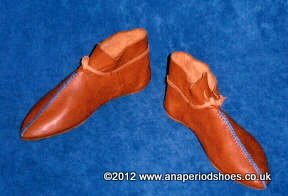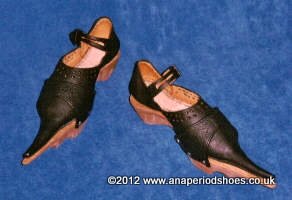Historic Craft Demonstration | Courses | Shoe Repairs | Authenticity | About ANA | Contact | Events | Links |
||
A Word on Authenticity
I take authenticity very seriously
I aim to make out shoes look 100% like the Real Thing. Bearing in mind that they are worn by modern people I have chosen to incorporate modern elements into a few models that are invisible and which make our footwear more durable and comfortable. I am very careful about making such design decisions, aiming at the highest quality while staying true to the historical originals.
If such changes from the historical original have been made, they are clearly indicated in the description of that model. For example an additional internal sole-layer in my prehistoric shoes, or an internal reinforcement strip of leather around the throat of a Viking boot.
My authenticity standards exceed the requirements of most re-enactment societies and they are very happy with my footwear.
You may be looking for an exhibit for a museum or for educational purposes, or you are very passionate about feeling exactly what it must have been like some thousand years ago. In this case I will be delighted to make you a pair that is an accurate copy of the archaeological finds I have studied. I am usually able to do this at no extra cost to you.
So what IS the difference?
The fully hand-stitched shoes are virtually indistinguishable from the historical originals until you unpick them and subject them to chemical analysis.
The machine-stitched shoes are sewn with a modern sewing machine to keep the cost down, but still produced in turn-shoe-construction and to historically accurate patterns. Once they are broken-in they look perfectly authentic.
The Patterns:
All our shoe and boot patterns are accurate reproductions of surviving footwear.
The Leather Uppers:
All our hand-stitched footwear is made from vegetable-tanned leather and is therefore in this aspect fully authentic. However, the machine-stitched versions are occasionally made from chrome-tanned leather to keep them affordable.
Leather is a natural material and variations in colour or score marks and other irregularities are proof of this rather than faults. This does not affect the functionality of my shoes. I will be pleased to send you samples of the leather that I will be using for your shoes before you place an order.
The Soles:
All my hand-stitched footwear has 6mm (1/4in) thick vegetable-tanned soles. This is thicker than the soles on medieval footwear would have been, but I am sure that you will be grateful not to feel any pebbles through them and appreciate the higher life-expectancy of these soles.
My machine-stitched shoes have 3.5mm (1/7in) thick vegetable-tanned soles. This is fully authentic, but they do not last quite as long as the hand-stitched ones.
The hand-stitched shoes where uppers and sole are cut from one piece have 3.5mm(1/7in) thick vegetable-tanned soles stitched and/or glued inside invisibly. This reinforcement makes them approximately three times more durable than such primitive shoes would have been.
If you wish to order such shoes purely for display purposes, please let me know and I will dispense with the additional sole.
Some of the hand-stitched shoes are available with a second leather sole stuck onto the original sole. This makes the shoes more durable and more comfortable, but this is obviously not authentic.
Heel Stiffeners:
Heel stiffeners are semicircular pieces of leather stitched inside the uppers to prevent the heels from buckling down concertina-style. These elements are fully authentic. However I add a bit of glue between the layers to ensure that the shoes keep their good shape for longer.
Small Heels:
I have seen just too many shoes that were otherwise perfectly good, but worn to a crescent-shaped hole at the heel. I think this is a waste and offer small heels of 6mm (1/4in) thick vegetable-tanned sole-leather as an extra with my hand-stitched footwear of the same sole-thickness. There is historic evidence for heel patches on shoes that had been worn through. My heel-patches are authentically tunnel-stitched to the soles and apart from the use of nylon thread exactly like the historical originals. This makes them easily replaceable when they have worn out. If you intend to walk a lot on tarmac we recommend that you have these heels attached. If you are sure that you will wear your shoes mostly on grass and indoors it is not necessary to order the heels.
Thread:
I do not use authentic thread on any of my shoes because they do not last as long as the modern alternatives or are simply unavailable.
On my thick-soled hand-stitched footwear I use artificial sinew which - once waxed authentically - looks exactly like authentic linen thread.
If you wish me to sew your shoes with authentic linen thread, for example because they are going to be an exhibit in a museum, just let me know.
My machine-stitched shoes are sewn with nylon thread, but all the stitching is hidden on the inside.
My one-piece shoes (prehistoric and early dark age) are stitched with artificial sinew. I would love to make these with real sinew or really tough rawhide-strips, so if you know a supplier I would be delighted to hear from you.
Painful Heels and Heel cushions:
Many people experience painful heels after prolonged periods of walking in flat-soled shoes because they are not used to them. Modern heel-cushions that you can put into your flat-heeled shoes will help. I offer heel-cushions as an extra with my shoes. They are modern leather covered latex cushions in a wedge-shape.
You are welcome to contact us with feedback or if you have any questions or need advice on appropriate footwear styles to match your clothing.
© Ana Deissler 11-2012


